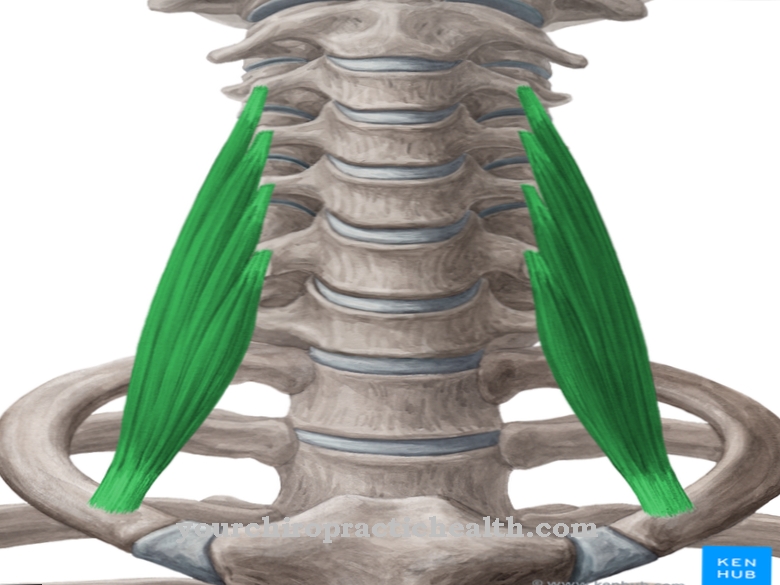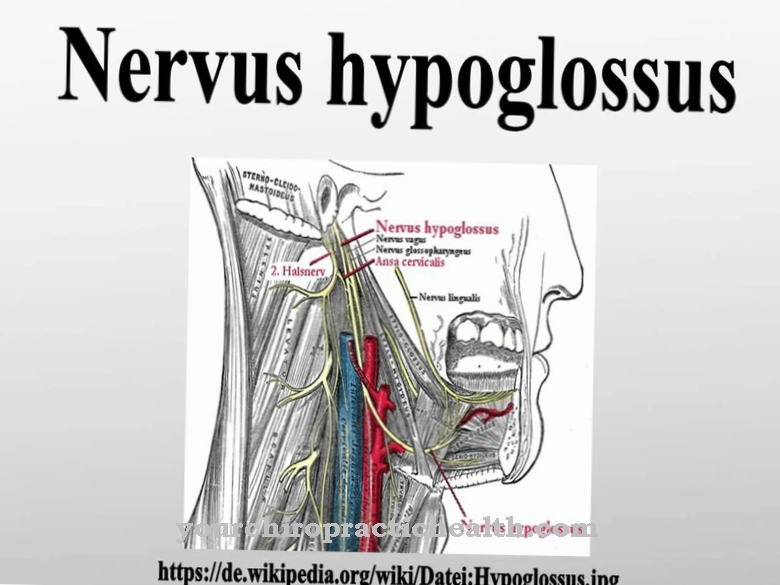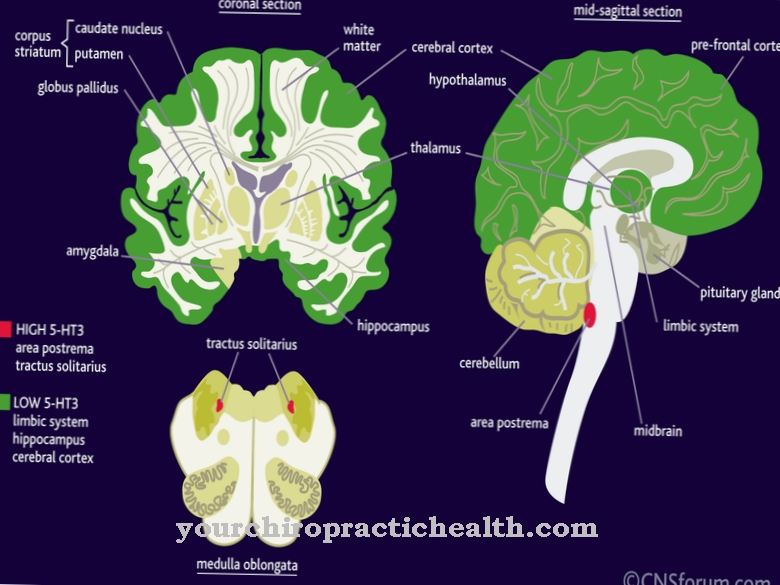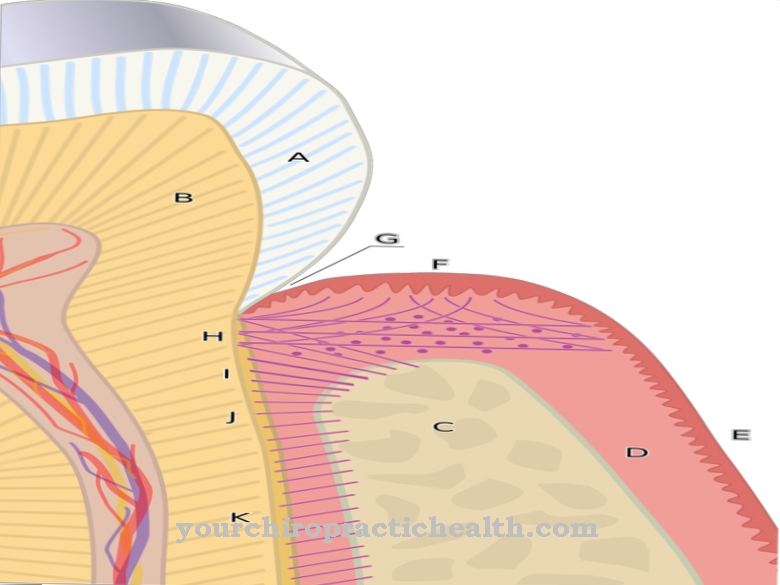The sarcoplasmic reticulum is a membrane system made of tubes that lies in the sarcoplasm of the muscle fibers. It supports the transport of substances within the cell and stores calcium ions, the release of which leads to muscle contraction. This task execution is impaired in various muscle diseases, for example in malignant hyperthermia or myofascial pain syndrome.
What is the sarcoplasmic reticulum?
The sarcoplasmic reticulum is a tubular membrane system inside muscle fibers. A muscle fiber corresponds to a muscle cell, but has several cell nuclei that are created by cell division (mitosis) and allow the fiber to grow in length as it develops.
Each muscle fiber is divided into other fibers, called myofibrils. They can be divided into transverse sections (sarcomeres), which give the striated skeletal muscles their name. The pattern is created by myosin and actin / tropomyosin filaments: very fine threads that slide into each other alternately according to the zipper principle. The smooth muscles also have a sarcoplasmic reticulum; it works similarly, but its structure is not that clearly divided into individual units. Instead, smooth muscles form a flat surface.
The sarcoplasmic reticulum is similar to the endoplasmic reticulum (ER), which is the inner membrane system in other cell types. Biology differentiates between smooth ER and rough ER; The latter has numerous ribosomes on the surface. These macromolecules synthesize proteins according to the blueprint provided by the genome. The sarcoplasmic reticulum is a smooth ER. Not only muscles have a smooth ER, but also organs such as the liver or kidney.
Anatomy & structure
In its entirety, the sarcoplasmic reticulum forms a complex tube system made up of membranes. It is located in the muscle fiber or muscle cell in the sarcoplasm. The sarcoplasmic reticulum spreads along the myofibrils and surrounds them, since the actual muscle contraction takes place in their sarcomeres. Mitochondria, which provide energy for the cell in the form of ATP, are often in close proximity and, like the sarcoplasmic reticulum, lie in the tissue between the individual myofibrils.
The membranes of the smooth ER form predominantly tubular structures, but also bags or cisterns and vesicles. They all have an interior space within the membrane, which biology also calls lumen. The tube system can adapt to the needs of the tissue by changing its structure and expanding it more in certain areas, creating new branches or joining several channels.
Function & tasks
As part of the muscle contraction, the sarcoplasmic reticulum helps to distribute incoming nerve signals in the muscle fiber and to cause the muscle to contract with the help of calcium ions. The reason for this is the signal from a nerve fiber that ends at the muscle. The neural information can come from the brain as well as from the spinal cord, via which many reflexes are connected.
At the end of the nerve fiber is the motor endplate, which, like the terminal button at the interneuronal synapse, contains vesicles that are filled with messenger substances (neurotransmitters). The neurotransmitters are released when the electrical impulse stimulates the motor endplate. The biochemical molecules then transmit the signal to the muscle membrane, where they open ion channels and thereby trigger a change in the cell's charge. The change in charge spreads through the sarcolemma and T-tubules.
The T-tubules are tubes that are perpendicular to the myofibrils; they lie on the Z-disks of the sarcomeres and are connected to the sarcoplasmic reticulum. When the tension reaches the sarcoplasmic reticulum, it releases stored calcium ions. These attach to the actin-tropomyosin filament and temporarily change its structure; as a result, the ends of the myosin filaments can slide further between the actin-tropomyosin fibers. In this way the muscle shortens.
The calcium ions do not bind permanently to the actin-tropomyosin complex, but then dissolve again. The sarcoplasmic reticulum then takes the charged particles back into its cisterns so that the process can be repeated the next time it is stimulated. Pumps in the membrane of the tube system bring the calcium ions back. In addition, like the endoplasmic reticulum in other cells, the sarcoplasmic reticulum supports the distribution of substances in the sarcoplasm, whereby it serves as a road for transport molecules.
You can find your medication here
➔ Medicines for painDiseases
Insufficient functionality of the sarcoplasmic reticulum has been linked to various muscular disorders and complications. One example of this is malignant hyperthermia, which can occur as a result of medical anesthesia.
It is characterized by muscle rigidity (rigidity), hyperacidity (metabolic acidosis), tachycardia, increased carbon dioxide content in the blood or in the air we breathe, oxygen deficiency and masticatory muscle spasm (on the masseter muscle, masseter spasm). The symptoms are due to an uncontrolled release of calcium ions in the muscle fiber, whereupon the tissue contracts like an arbitrary irritation, the cell quickly suffers from a lack of energy and produces large amounts of heat and carbon dioxide.
Various clinical symptoms are the result, including muscle fiber breakdown (rhabdomyolysis). The cause of malignant hyperthermia is a genetic predisposition that leads to receptor changes. The administration of certain anesthetics triggers a false reaction, which is why medicine also speaks of trigger substances in this context.
In myofascial pain syndrome, hardening occurs in the muscle tissue, which is also known as trigger points. The hardening comes about through a prolonged muscle contraction: Due to insufficient supply of the affected area, the endoplasmic reticulum is not able to pump the released calcium ions back into its interior. The ions are still available and ensure that the muscle contraction continues.
























.jpg)



